Search Result
Results for "
tumor of prostate
" in MedChemExpress (MCE) Product Catalog:
3
Isotope-Labeled Compounds
| Cat. No. |
Product Name |
Target |
Research Areas |
Chemical Structure |
-
- HY-78884
-
|
|
Amino Acid Derivatives
|
Cancer
|
|
Anticancer agent 9, a glycine derivative, is an anticancer agent. Anticancer agent 9 can inhibit tumor cells viability of myelogenous leukemia and human prostate cancer .
|
-
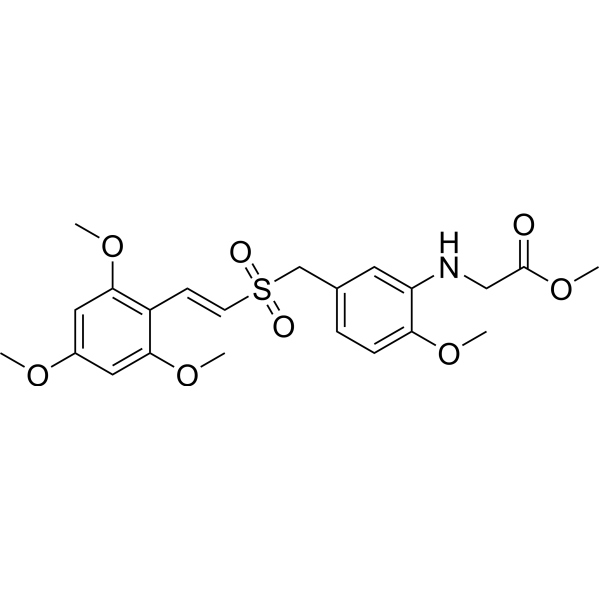
-
- HY-P99217
-
|
AMG 102
|
c-Met/HGFR
|
Cancer
|
|
Rilotumumab (AMG 102) is an anti-HGF (anti-hepatocyte growth factor) monoclonal antibody, inhibits HGF/MET-driven signaling. Rilotumumab shows anti-tumor activity, and can be used in castration-resistant prostate cancer (CRPC) and solid tumor research .
|
-

-
- HY-18933
-
|
|
Akt
|
Cancer
|
|
BI-69A11 is an AKT inhibitor that can effectively suppress the phosphorylation of AKT. BI-69A11 exhibits anticancer activity and can lead to the death of melanoma cells and prostate tumor cells .
|
-
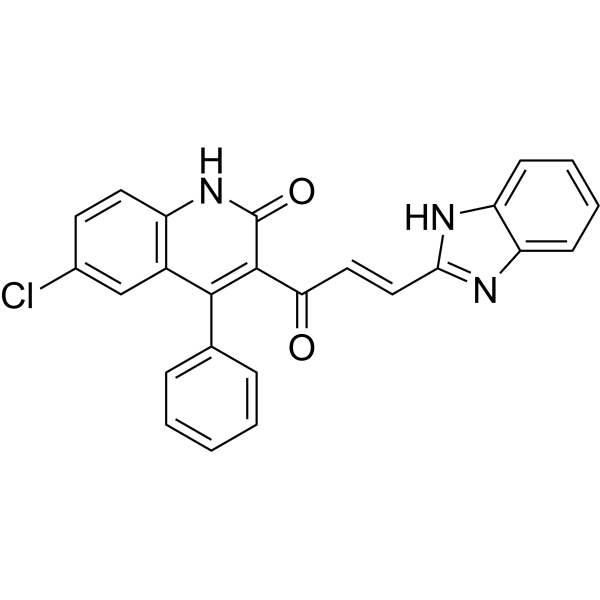
-
- HY-P5290
-
|
|
PSMA
|
Cancer
|
|
HYNIC-PSMA is a ligand for molecular imaging of tumors. Hynic-psma consists of two components: HYNIC (6-hydrazinonicotinamide) and PSMA (Prostate-Specific Membrane Antigen). HYNIC is a compound used to attach radioactive isotopes to targeted molecules, such as 188Re-HYNIC-PSMA. PSMA is a membrane antigen that is specifically expressed on the surface of prostate cancer cells. HYNIC-PSMA can be used in prostate cancer research .
|
-
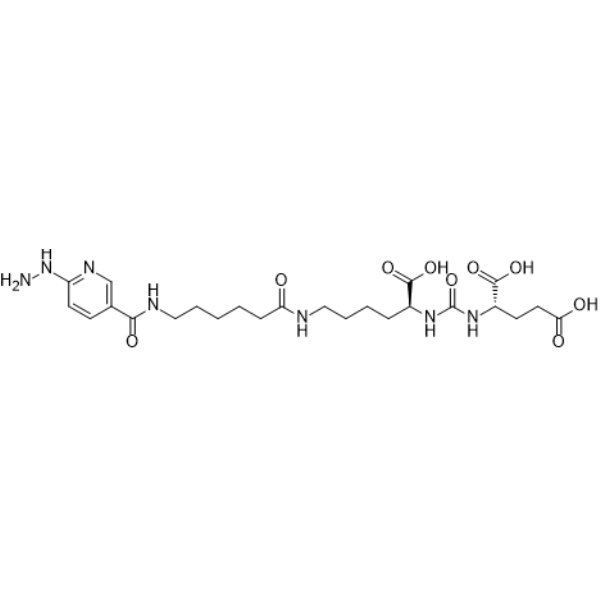
-
- HY-160020
-
|
|
Androgen Receptor
|
Cancer
|
|
ET516 is a potent inhibitor of Androgen Receptor. ET516 significantly inhibits the proliferation and tumor growth of prostate cancer cells expressing AR-resistant mutants .
|
-
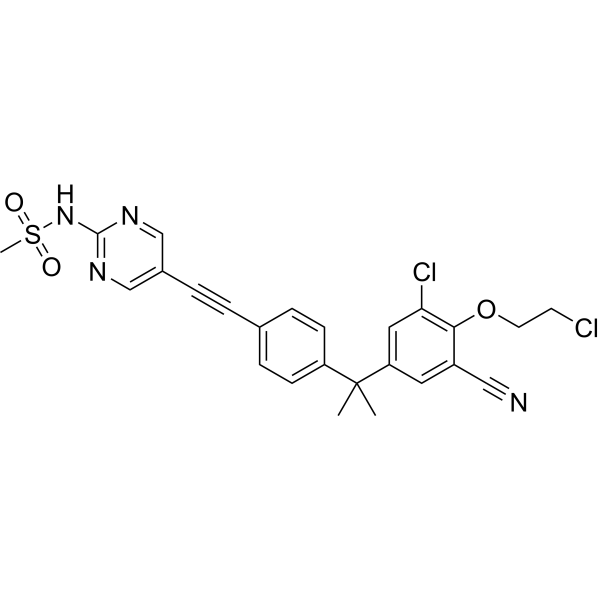
-
- HY-106056
-
|
D 16726
|
Others
|
Cancer
|
|
Zindoxifene is a partial anti-estrogen. Zindoxifene works primarily by binding to estrogen receptors, thereby inhibiting the growth of estrogen-dependent tumor cells. Zindoxifene is able to exhibit the dual properties of estrogen agonists and antagonists and can be used in research and development to target estrogen-dependent tumors, such as prostate and breast cancer .
|
-

-
- HY-161699
-
|
|
PSMA
|
Cancer
|
|
SDTWS01 is a novel 68Ga-labeled prostate-specific membrane antigen (PSMA) targeting tracer. The inhibition constant (Ki) of SDTWS01 for PSMA is in the nanomolar range (less than 10 nM), demonstrating high affinity for PSMA. SDTWS01 exhibits significant tumor uptake and superior PET imaging effects. SDTWS01 can be utilized for diagnostic research of prostate cancer .
|
-

-
- HY-P5292
-
|
|
PSMA
|
Cancer
|
|
HYNIC-iPSMA is a ligand for molecular imaging of tumors. Hynic-ipsma consists of two components: HYNIC (6-hydrazinonicotinamide) and iPSMA (Inhibitor of Prostate-Specific Membrane Antigen). HYNIC is a compound used to attach radioactive isotopes to targeted molecules. iPSMA is a specific inhibitor used to inhibit prostate-specific membrane antigen (PSMA). 68GA-labeled iPSMA has been used to detect prostate cancer by PET imaging. The further 99mTc-EDDA/HYNIC-iPSMA has excellent specificity and sensitivity .
|
-
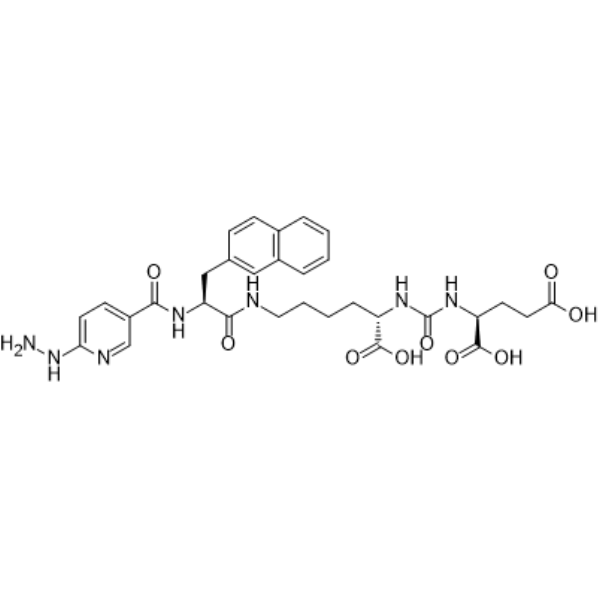
-
- HY-P5292A
-
|
|
PSMA
|
Cancer
|
|
HYNIC-iPSMA TFA is a ligand for molecular imaging of tumors. Hynic-ipsma consists of two components: HYNIC (6-hydrazinonicotinamide) and iPSMA (Inhibitor of Prostate-Specific Membrane Antigen). HYNIC is a compound used to attach radioactive isotopes to targeted molecules. iPSMA is a specific inhibitor used to inhibit prostate-specific membrane antigen (PSMA). 68GA-labeled iPSMA has been used to detect prostate cancer by PET imaging. The further 99mTc-EDDA/HYNIC-iPSMA TFA has excellent specificity and sensitivity .
|
-

-
- HY-N6601
-
|
Randialic acid A
|
Apoptosis
|
Cancer
|
|
Randialic acid A (Pomolic acid) is a pentacyclic triterpene isolated from Euscaphis japonica (Tunb.). Randialic acid A (Pomolic acid) inhibits tumor cells growth and induces cell apoptosis. Randialic acid A (Pomolic acid) has a potential for the treatment of prostate cancer (PC) .
|
-
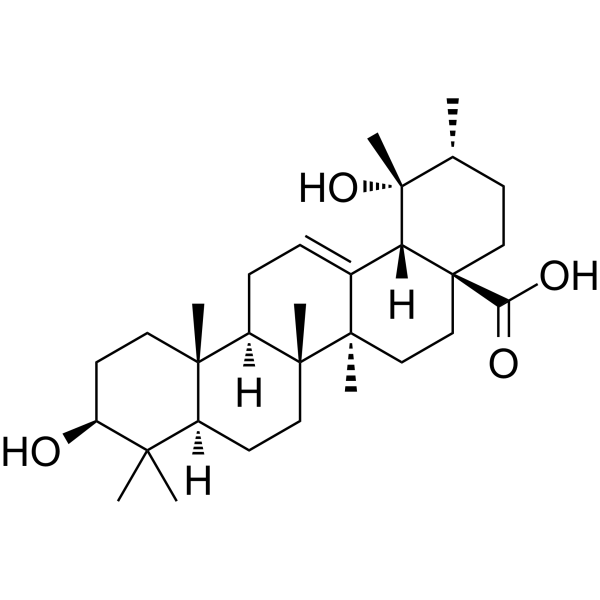
-
- HY-141729
-
|
|
Fluorescent Dye
|
Cancer
|
|
Biotin-NH-PSMA-617 is a biotin-tagged PSMA-617. PSMA-617 is a small molecule targeting the prostate-specific membrane antigen (PSMA), which is directly expressed by the tumor cells .
|
-
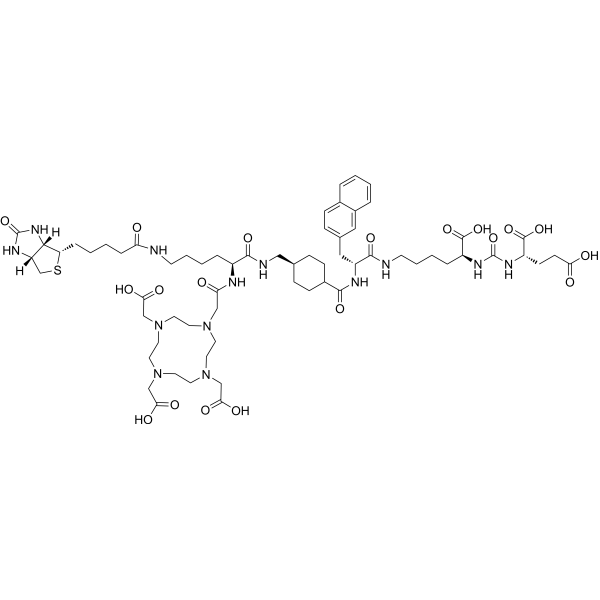
-
- HY-132292
-
|
|
PROTACs
Androgen Receptor
|
Cancer
|
|
ARD-2128 is a highly potent, orally bioavailable PROTAC androgen receptor (AR) degrader. ARD-2128 effectively reduces AR protein, suppresses AR-regulated genes in tumor tissues, and inhibits growth of tumor without signs of toxicity. ARD-2128 has the potential for the research of the prostate cancer .
|
-

-
- HY-125065
-
|
|
Androgen Receptor
5 alpha Reductase
|
Endocrinology
Cancer
|
|
MK-4541 is an orally active and selective androgen receptor (AR) modulator. MK-4541 acts as an antagonist to inhibit 5α-reductase. MK-4541 inhibits proliferation and induces apoptosis in AR positive prostate cancer cells. MK-4541 significantly inhibited the growth of R3327-G prostate tumors in xenograft mouse model .
|
-

-
- HY-139453
-
|
|
Others
|
Cancer
|
|
LP-184 (compound 6), an acylfulvene analog, inhibits tumor growth. LP-184 has potent anti-cancer activity in the ovarian, colon, prostate and pancreatic cell lines. (patent WO2007019308A2).
|
-
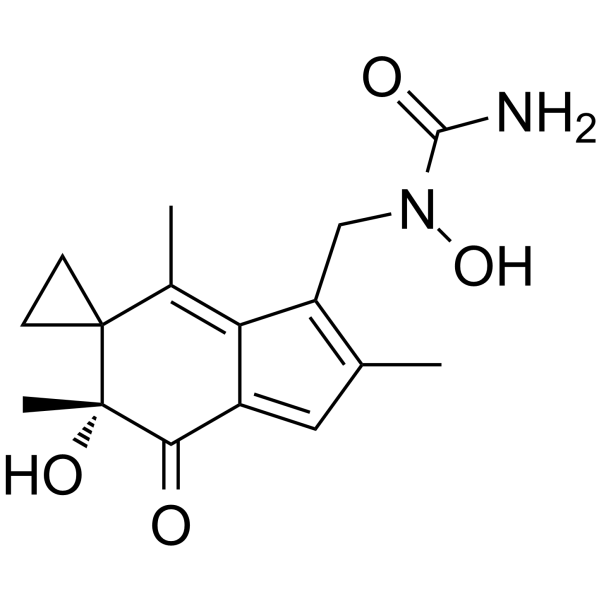
-
- HY-N10265
-
|
|
Endogenous Metabolite
|
Cancer
|
|
Stephacidin B is a fungal metabolite. Stephacidin B shows in vitro cytotoxicity against a panel of human tumor cell lines. Stephacidin B shows the strongest cytotoxicity against testosterone-dependent prostate LNCaP cancer cells .
|
-
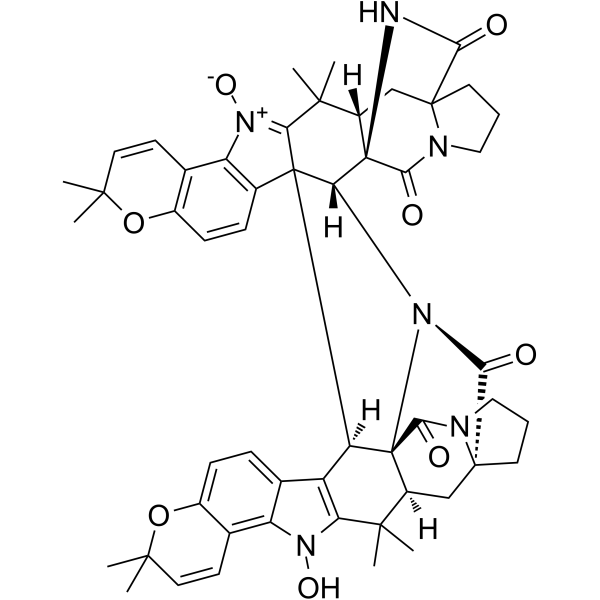
-
- HY-103711
-
|
|
Microtubule/Tubulin
|
Cancer
|
|
Estramustine is an antineoplastic agent. Estramustine depolymerizes microtnbules by binding to tubulin 1, exhibits antimitotic activity with an IC50 value of ~16 μM for mitosis of DU 145 cells. Estramustine blocks cells at mitosis in prostate tumor xenografts .
|
-
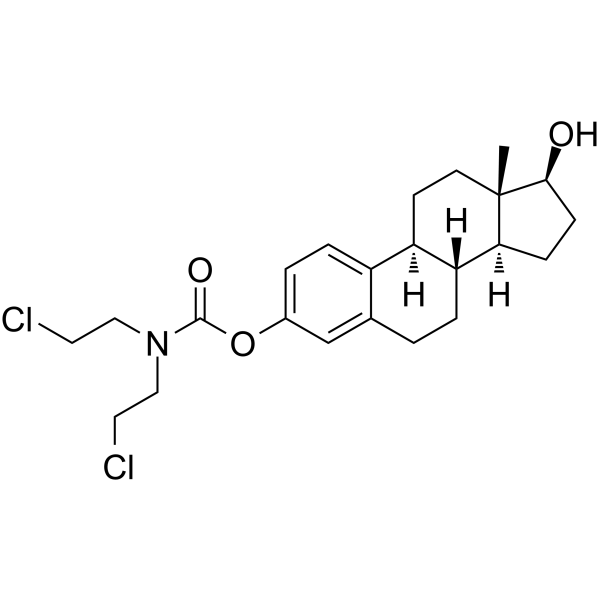
-
- HY-149297
-
|
|
PSMA
|
Cancer
|
|
PSMA-IN-1 (compound 23) is an inhibitor of PSMA with a Ki value of 2.49 nM. PSMA-IN-1 inhibits tumor growth with high selectivity and specificity in PSMA+ xenograft models. PSMA-IN-1 is a NIR probe (λEX: 620 nm; λEM: 670 nm) used for tumor disappearance. PSMA-IN-1 can be used for research on prostate cancer .
|
-
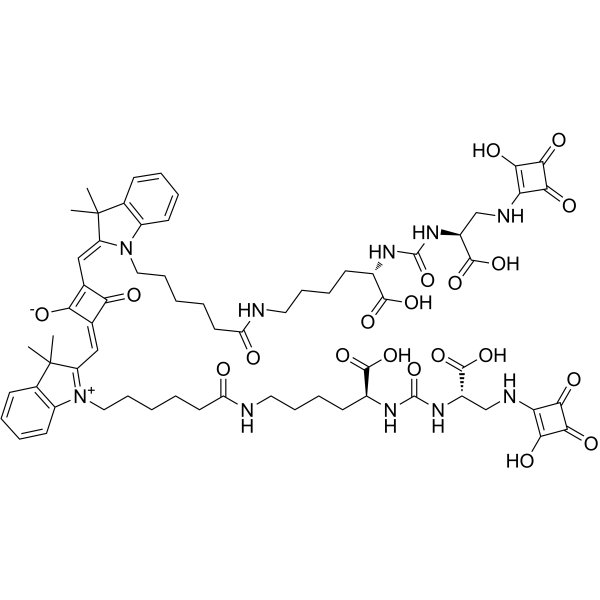
-
- HY-111145
-
|
|
Androgen Receptor
|
Cancer
|
|
RD162, a diarylthiohydantoin, is an orally active non-steroidal antiandrogen (NSAA). RD162 specifically binds to androgen receptor (AR). RD162 induces tumor regression in mouse models of castration-resistant human prostate cancer .
|
-
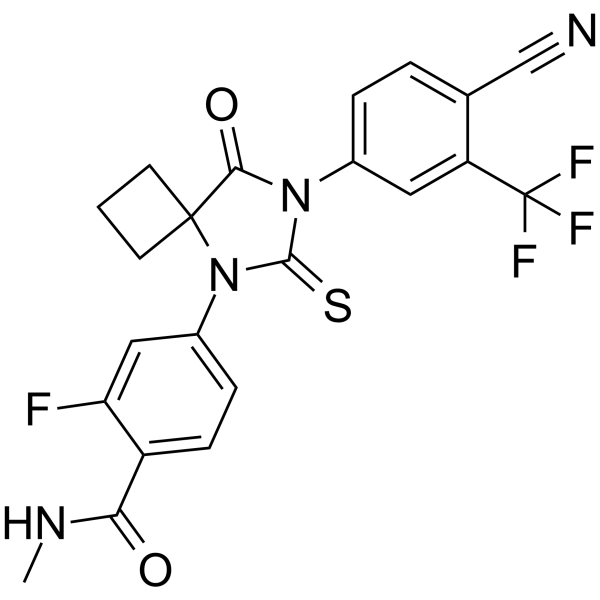
-
- HY-126412
-
|
|
Apoptosis
|
Cancer
|
|
Neochamaejasmine A is a biflavonoid that can be isolated from the roots of Stellera chamaejasme L.. Neochamaejasmine A inhibits proliferation, induces cell cycle arrest and apoptosis in tumor cells. Neochamaejasmine A can be used in the research of cancers such as prostate cancer, hepatoma cancer .
|
-
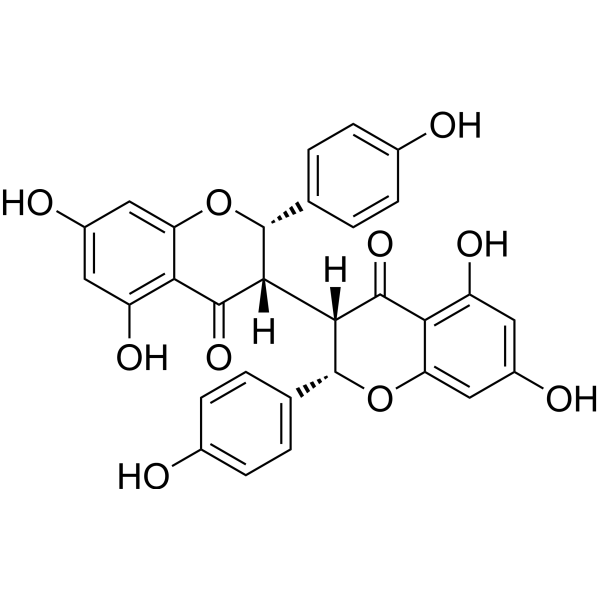
-
- HY-155994
-
|
|
PIKfyve
Autophagy
PROTACs
|
Cancer
|
|
PIK5-12d is a PROTAC PIKfyve degrader (DC50: 1.48 nM). PIK5-12d induces massive cytoplasmic vacuolization and blocks autophagic flux in multiple prostate cancer cells. PIK5-12d inhibits prostate cancer cell proliferation. PIK5-12d has anti-tumor activity .
|
-
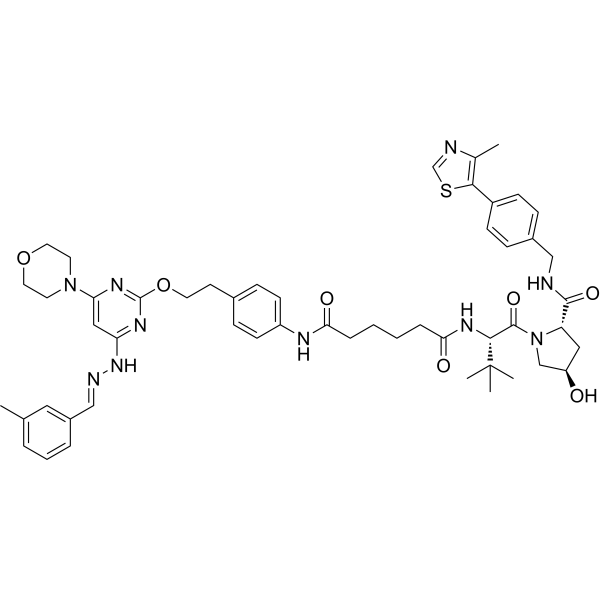
-
- HY-124628
-
|
|
Fatty Acid Synthase (FASN)
|
Cancer
|
|
IPI-9119 is an orally active, selective and irreversible FASN inhibitor with an IC50 of 0.3 nM in vitro biochemical assay. IPI-9119 inhibits tumor growth of castration-resistant prostate cancer (CRPC) xenografts mouse models .
|
-
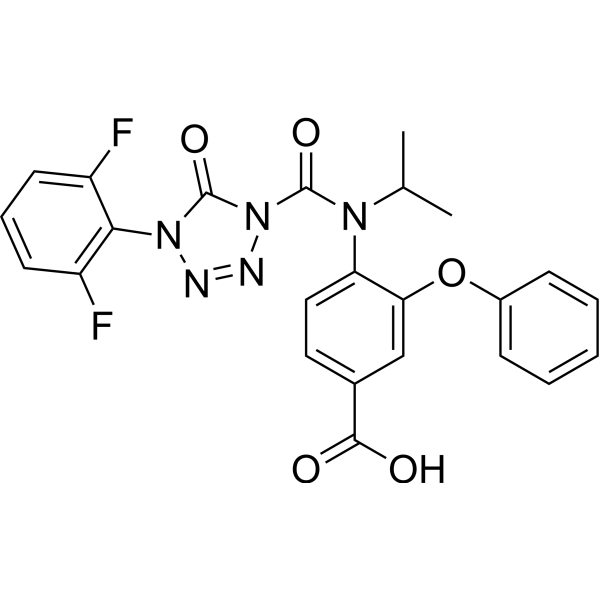
-
- HY-106431
-
|
Olpadronate; OLP
|
Others
|
Metabolic Disease
Cancer
|
|
Olpadronic acid (Olpadronate) is an orally active amino-bisphosphonate and inhibits bone resorption. Olpadronic acid also prevents bone destruction and tumor growth in the skeletal prostate cancer mouse model. Olpadronic acid can be used for research of osteoporosis, malignancies and rheumatoid arthritis .
|
-

-
- HY-163683
-
|
|
Drug-Linker Conjugates for ADC
|
Cancer
|
|
EB-PSMA-617 is a modified form of PSMA-617 that has enhanced pharmacokinetic properties by conjugating it to Evans Blue (EB) to extend its circulation half-life to improve prostate tumor uptake and radiotherapy efficacy. In preclinical studies using PC3-PIP-loaded mice, EB-PSMA-617 demonstrated prolonged blood half-life, increased accumulation in PSMA-positive tumors, and successful tumor elimination with lower radioactivity .
|
-

-
- HY-139180
-
PRGL493
3 Publications Verification
|
Others
|
Cancer
|
|
PRGL493 is a potent and selective long-chain acyl-CoA synthetase 4 (ACSL4) inhibitor. PRGL493 blocks cell proliferation and tumor growth in both breast and prostate cellular and animal models. PRGL493 is used for cancer research .
|
-
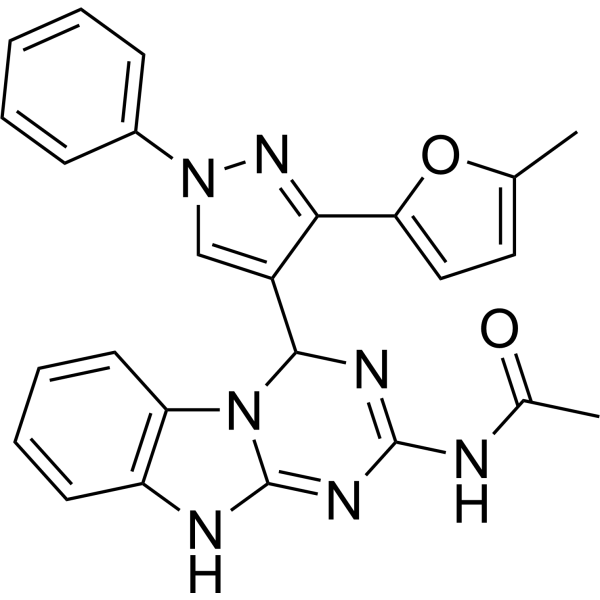
-
- HY-148777
-
|
|
PROTACs
Androgen Receptor
|
Cancer
|
|
A031 is a highly effective PROTAC androgen receptor (AR) degrader with an IC50 value less than 0.25 μM for AR protein degradation. A031 has an inhibitory effect on tumor growth in zebrafish with human prostate cancer (VCaP) .
|
-

-
- HY-120599
-
|
VERU-111; ABI-231
|
Microtubule/Tubulin
Apoptosis
HPV
|
Cancer
|
|
VERU-111 (ABI-231) is a potent and orally active α and β tubulin inhibitor, which displays strong antiproliferative activity, with an average IC50 of 5.2 nM against panels of melanoma and prostate cancer cell lines. VERU-111 (ABI-231) suppresses tumor growth and metastatic phenotypes of cervical cancer cells via targeting HPV E6 and E7, and has potential for the treatment of prostate cancer .
|
-
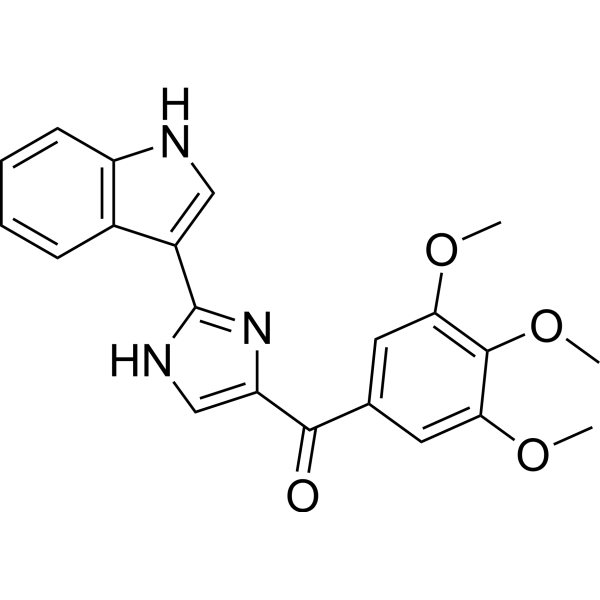
-
- HY-121524
-
|
|
Microtubule/Tubulin
|
Cancer
|
|
DJ101 is a potent and metabolically stable tubulin inhibitor. DJ101 targets the colchicine binding site and overcomes taxane resistance. DJ101 also inhibits melanoma tumor growth and lung metastasis. DJ101 can be used for prostate cancer research .
|
-

-
- HY-158101
-
|
CC-94676
|
Androgen Receptor
|
Cancer
|
|
BMS-986365 is a selective heterobifunctional ligand-directed degrader (LDD) targeting the androgen receptor (AR). BMS-986365 demonstrated significant in vivo potency, degrading AR, inhibiting AR signaling, and inhibiting tumor growth in animal models of advanced prostate cancer.
|
-
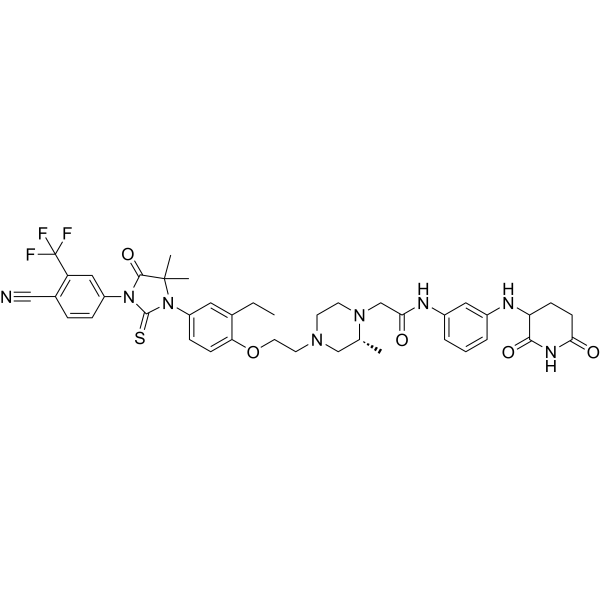
-
- HY-W018723
-
|
p-Aminobenzamidine dihydrochloride
|
Ser/Thr Protease
|
Cancer
|
|
4-Aminobenzamidine (p-Aminobenzamidine) dihydrochloride is a strong trypsin inhibitor, also acting as a relatively weak urokinase type plasminogen activator (uPA) inhibitor (Ki=82 μM). 4-Aminobenzamidine can inhibit growth of a human prostate tumor in SCID mice .
|
-
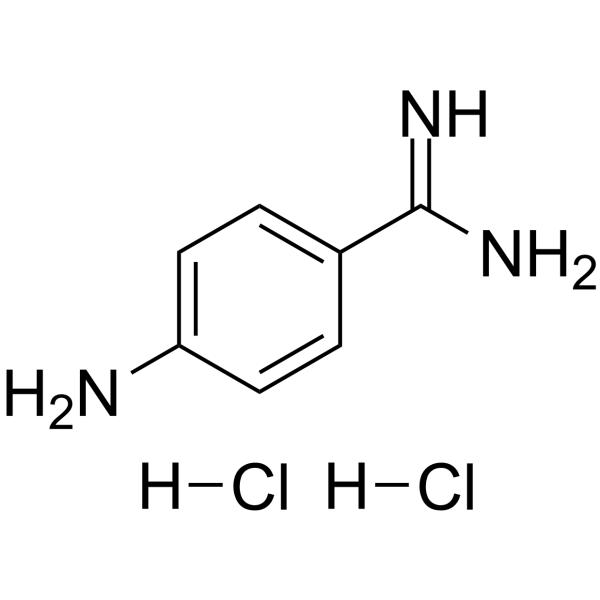
-
- HY-156594
-
|
SarbisPSMA
|
Others
|
Cancer
|
|
Abefolastat tesaroxetan (SarbisPSMA) is a bivalent sarcophagine conjugate. Abefolastat tesaroxetan (SarbisPSMA) can be readily radiolabeled with positron-emitting copper-64 at room temperature and outperforms the monomeric agent with respect to tumor uptake and retention. Abefolastat tesaroxetan (SarbisPSMA) can be used for prostate cancer research .
|
-

-
- HY-124056
-
|
|
CXCR
|
Cancer
|
|
AZ10397767 is an orally active, selective CXCR2 receptor antagonist with an IC50 of 1 nM. AZ10397767 attenuates the Oxaliplatin (HY-17371)-induced NF-κB transcriptional activity and potentiates Oxaliplatin-induced apoptosis in androgen-independent prostate cancer (AIPC) cells. AZ10397767 significantly inhibits neutrophil recruitment into tumors which then adversely affects tumor growth in vitro and in vivo .
|
-
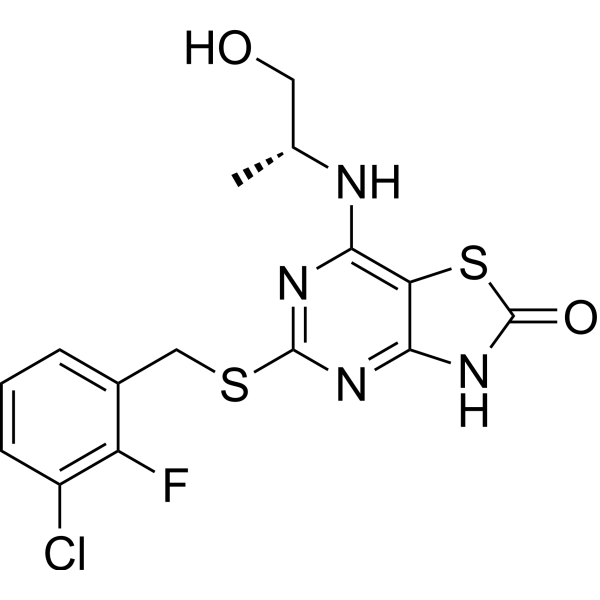
-
- HY-158251
-
|
|
Others
|
Cancer
|
|
BIBD-300 is a PARP-1 imaging agent with high affinity for PARP-1. BIBD-300 can accurately localize C6 and U87MG tumors, which can be used for research in the diagnosis of breast cancer, prostate cancer, glioma, and liver cancer .
|
-

-
- HY-131724
-
|
p-DDAP; p-Dodecylaminophenol
|
Apoptosis
|
Cancer
|
|
4-(Dodecylamino)phenol (p-DDAP) is an anticancer agent. 4-(Dodecylamino)phenol has anti-tumor activity and can suppress proliferation, arrest the cell cycle and induce apoptotic cell death. 4-(Dodecylamino)phenol can be used for the research of cancer, such as prostate cancer .
|
-
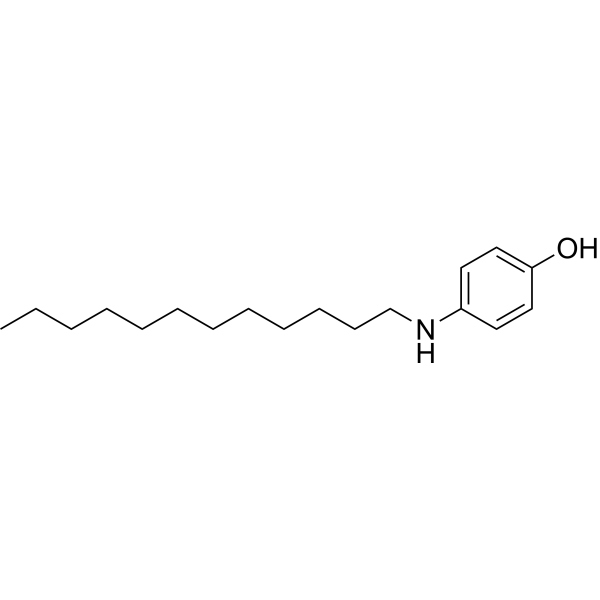
-
- HY-155458
-
|
|
PARP
|
Inflammation/Immunology
Cancer
|
|
HYDAMTIQ is a PARP-1/2 inhibitor (IC50: 29-38 nM) with anticancer, anti-inflammatory, and ischemic protective effects. HYDAMTIQ inhibits pulmonary PARP activity, is effective against allergen-induced cough and dyspnea, and inhibits bronchial hyperresponsiveness to methacholine. HYDAMTIQ has broad-spectrum tumor suppressor effects, including ovarian and breast cancers, prostate and pancreatic tumors, and glioblastoma multiforme. HYDAMTIQ has demonstrated in vivo efficacy in animal models of cerebral ischemia, asthma, cancer, and more .
|
-
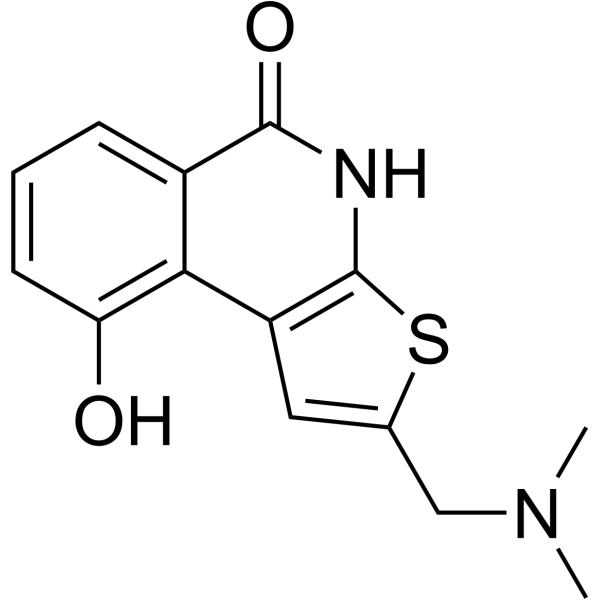
-
- HY-16160
-
|
|
Autophagy
ICMT
|
Cancer
|
|
Cysmethynil is an Icmt inhibitor(IC50 = 2.4 μM). Cysmethynil inhibites RAS membrane binding and EGF signal transduction. Cysmethynil prevents the cells in the G1 phase and induces autophagy. Cysmethynil inhibits PC3 cells proliferation, has synergistic effect with Paclitaxel (HY-B0015) and Doxorubicin (HY-15142A). Cysmethynil has anti-tumor effects and can be used for solid tumor (such as prostate cancer et al.) research .
|
-

-
- HY-123310
-
|
|
Androgen Receptor
|
Cancer
|
|
JNJ-26146900 is a potent and orally active androgen receptor antagonist with a Ki value of 400nM for rat AR. JNJ-26146900 is a nonsteroidal androgen receptor (AR) ligand. JNJ-26146900 reduces prostate tumor size and prevents bone loss. JNJ-26146900 can be used in research of cancer .
|
-
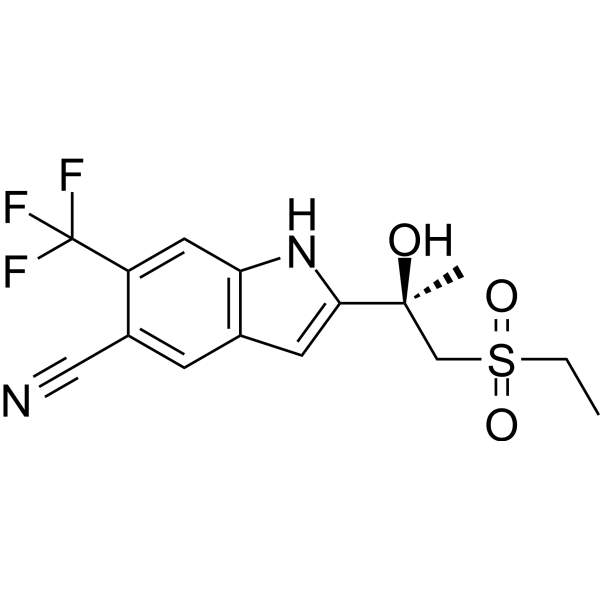
-
- HY-N0790
-
Lupeol
3 Publications Verification
Clerodol; Monogynol B; Fagarasterol
|
Androgen Receptor
Apoptosis
|
Cancer
|
|
Lupeol (Clerodol; Monogynol B; Fagarasterol) is an active pentacyclic triterpenoid, has anti-oxidant, anti-mutagenic, anti-tumor and anti-inflammatory activity. Lupeol is a potent androgen receptor (AR) inhibitor and can be used for cancer research, especially prostate cancer of androgen-dependent phenotype (ADPC) and castration resistant phenotype (CRPC) .
|
-

-
- HY-111614
-
|
|
Progesterone Receptor
|
Metabolic Disease
Cancer
|
|
Melengestrol acetate is a progesterone derivative, acts as an orally active corticosteroid hormone to promote endometrial proliferation, pregnancy maintenance, and delay of menstrual activity . Melengestrol Acetate is used as a contraceptive agent for growth promoting effects and suppression of estrus in animals. Melengestrol acetate inhibits both the androgen-dependent and -independent prostatic tumors in vivo and can be used for cancer research .
|
-
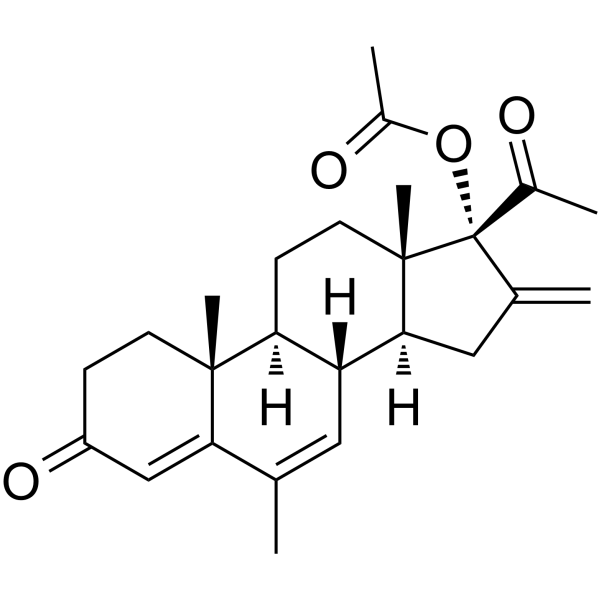
-
- HY-144671
-
|
|
Aldehyde Dehydrogenase (ALDH)
|
Cancer
|
|
ALDH3A1-IN-2 (Compound 19) is a potent inhibitor of ALDH3A1 with an IC50 of 1.29 μM. Aldehyde dehydrogenases (ALDHs) are overexpressed in various tumor types including prostate cancer. ALDH3A1-IN-2 has the potential for the research of cancer diseases .
|
-
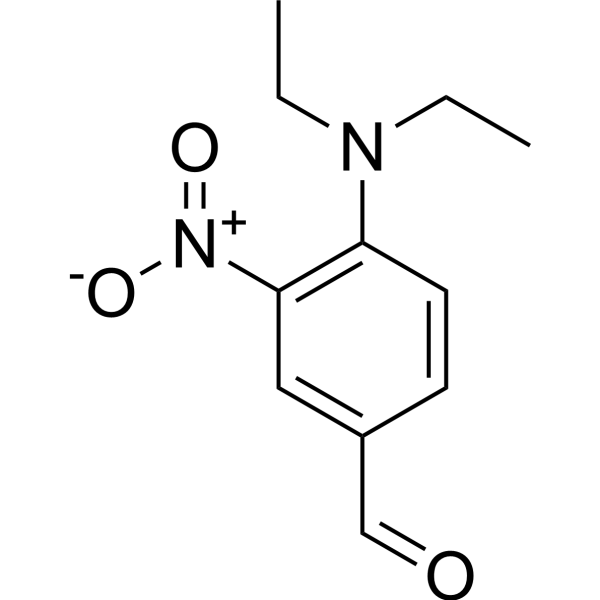
-
- HY-144669
-
|
|
Aldehyde Dehydrogenase (ALDH)
|
Cancer
|
|
ALDH1A3-IN-2 (Compound 15) is a potent inhibitor of ALDH1A3 with an IC50 of 1.29 μM. Aldehyde dehydrogenases (ALDHs) are overexpressed in various tumor types including prostate cancer. ALDH1A3-IN-2 has the potential for the research of cancer diseases .
|
-
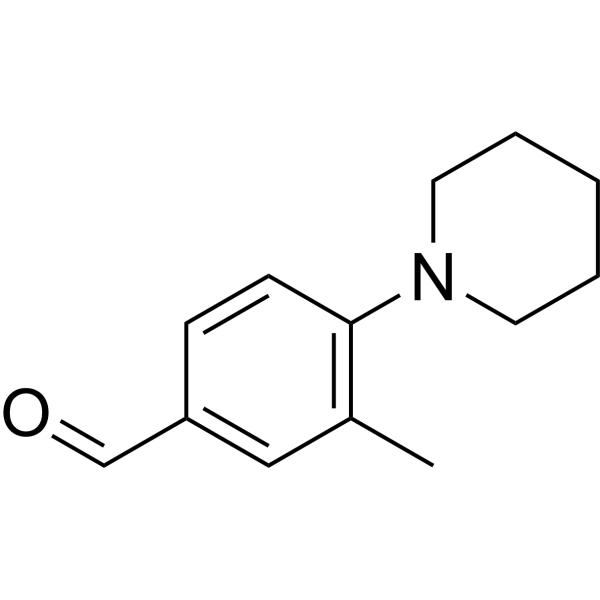
-
- HY-151576
-
|
|
Others
|
Cancer
|
|
PRMT5:MEP50 PPI is a novel PRMT5:MEP50 protein-protein interaction (PRMT5:MEP50 PPI) inhibitor, shows anti-tumor activity and anti-proliferative activity of lung and prostate cancer cells .
|
-

-
- HY-163062
-
|
|
Microtubule/Tubulin
Apoptosis
Complement System
|
Cancer
|
|
Tubulin/NRP1-IN-1 (compound TN-2) is a dual inhibitor of Tubulin and NRP1 with IC50s of 0.71 and 0.85 μM, respectively. Tubulin/NRP1-IN-1 significantly inhibits the viability of prostate tumor cell lines and induces apoptosis .
|
-

-
- HY-147696
-
|
|
HSP
AMPK
Reactive Oxygen Species
|
Cancer
|
|
SMTIN-T140 (compound 6a) is a potent TRAP1 (tumor-necrosis-factor-receptor associated protein 1) inhibitor, with an IC50 of 1.646 μM. SMTIN-T140 shows anticancer activity. SMTIN-T140 leads to mitochondrial dysfunction, increases mitochondrial ROS production and activates AMPK. SMTIN-T140 potently suppressed tumor growth without any noticeable in vivo toxicity in a mouse model xenografted with PC3 prostate cancer cells .
|
-

-
- HY-135671
-
|
|
Aryl Hydrocarbon Receptor
VEGFR
Estrogen Receptor/ERR
|
Endocrinology
Cancer
|
|
AhR modulator-1 (compound 6-MCDF) is a selective and orally active aryl hydrocarbon receptor (AhR) modulator. AhR modulator-1 inhibits metastasis, in part, by inhibiting prostatic VEGF production prior to tumor formation. AhR modulator-1 also possess anti-estrogenic properties in rat uterus .
|
-
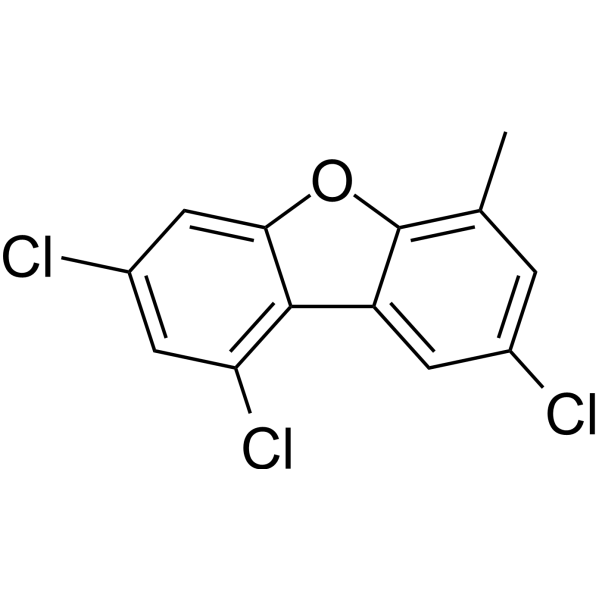
-
- HY-144670
-
|
|
Aldehyde Dehydrogenase (ALDH)
|
Cancer
|
|
ALDH3A1-IN-1 (Compound 18) is a potent inhibitor of ALDH3A1 with an IC50 of 1.61 μM. ALDH3A1-IN-1 is more potent than DEAB against patient-derived primary prostate tumor epithelial cells, as single agents or in combination research with docetaxel .
|
-
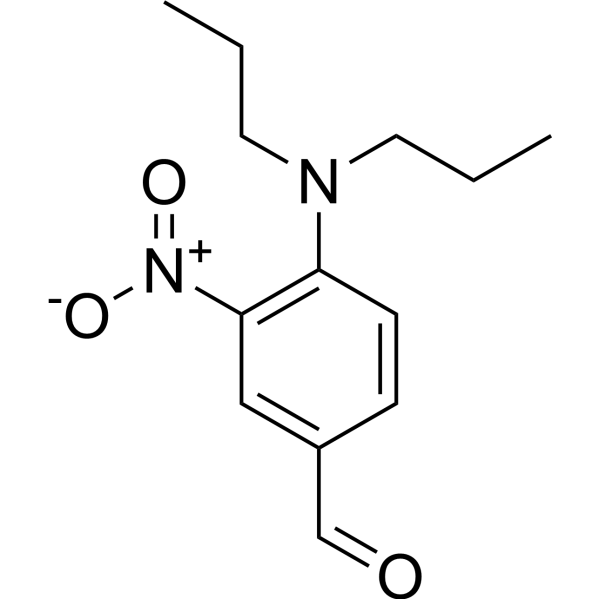
-
- HY-153396
-
|
|
Ceramidase
|
Cancer
|
|
Acid Ceramidase-IN-2 (compound 1) is an acid ceramidase inhibitor with potentially antiproliferative and cytostatic activities. Moreover, human acid ceramidase is overexpressed in prostate cancer cells, indicating potential anti-tumor effect of Acid Ceramidase-IN-2. And Acid Ceramidase-IN-2 hydrolysis can be inhibited by 3 a-ketoamides GT85, GT98 and GT99 inhibits in vitro .
|
-

-
- HY-N0103
-
|
|
Autophagy
Apoptosis
PI3K
Akt
Influenza Virus
|
Infection
Inflammation/Immunology
Cancer
|
|
Sophocarpine is one of the significant alkaloid extracted from the traditional herb medicine Sophora flavescens which has many pharmacological properties such as anti-virus, anti-tumor, anti-inflammatory. Sophocarpine significantly inhibits the growth of gastric cancer (GC) cells through multiple mechanisms such as induction of autophagy, activation of cell apoptosis and down-regulation of cell survival PI3K/AKT signaling pathway. Sophocarpine has been demonstrated to have anti-tumor activity in various cancer cells, including hepatocellular carcinoma, prostate cancer and colorectal cancer .
|
-

-
- HY-N0103A
-
|
|
Autophagy
Apoptosis
PI3K
Akt
Influenza Virus
|
Infection
Inflammation/Immunology
Cancer
|
|
Sophocarpine (monohydrate) is one of the significant alkaloid extracted from the traditional herb medicine Sophora flavescens which has many pharmacological properties such as anti-virus, anti-tumor, anti-inflammatory. Sophocarpine (monohydrate) significantly inhibits the growth of gastric cancer (GC) cells through multiple mechanisms such as induction of autophagy, activation of cell apoptosis and down-regulation of cell survival PI3K/AKT signaling pathway. Sophocarpine (monohydrate) has been demonstrated to have anti-tumor activity in various cancer cells, including hepatocellular carcinoma, prostate cancer and colorectal cancer .
|
-

-
- HY-111614S
-
|
|
Progesterone Receptor
|
Metabolic Disease
Cancer
|
|
Melengestrol acetate-d6 is the deuterium labeled Melengestrol acetate. Melengestrol acetate is a progesterone derivative, acts as an orally active corticosteroid hormone to promote endometrial proliferation, pregnancy maintenance, and delay of menstrual activity[1]. Melengestrol Acetate is used as a contraceptive agent for growth promoting effects and suppression of estrus in animals. Melengestrol acetate inhibits both the androgen-dependent and -independent prostatic tumors in vivo and can be used for cancer research[2].
|
-
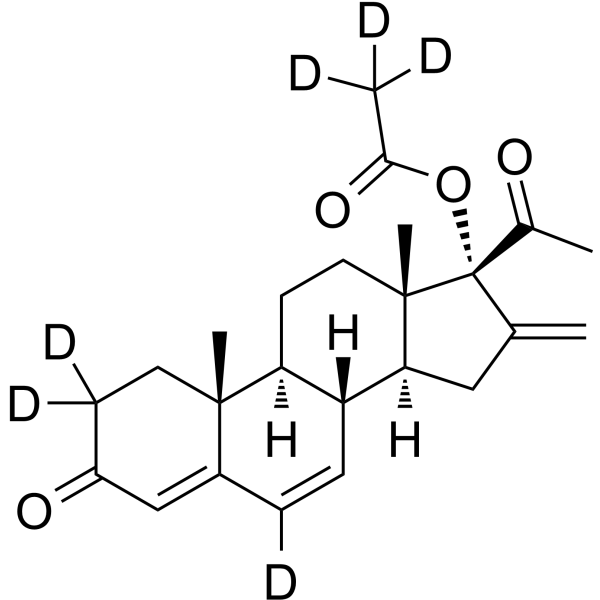
-
- HY-111614S1
-
|
|
Progesterone Receptor
|
Metabolic Disease
Cancer
|
|
Melengestrol acetate-d2 is the deuterium labeled Melengestrol acetate. Melengestrol acetate is a progesterone derivative, acts as an orally active corticosteroid hormone to promote endometrial proliferation, pregnancy maintenance, and delay of menstrual activity[1]. Melengestrol Acetate is used as a contraceptive agent for growth promoting effects and suppression of estrus in animals. Melengestrol acetate inhibits both the androgen-dependent and -independent prostatic tumors in vivo and can be used for cancer research[2].
|
-

- HY-111614S2
-
|
|
Progesterone Receptor
|
Metabolic Disease
Cancer
|
|
Melengestrol acetate-d3 is the deuterium labeled Melengestrol acetate. Melengestrol acetate is a progesterone derivative, acts as an orally active corticosteroid hormone to promote endometrial proliferation, pregnancy maintenance, and delay of menstrual activity[1]. Melengestrol Acetate is used as a contraceptive agent for growth promoting effects and suppression of estrus in animals. Melengestrol acetate inhibits both the androgen-dependent and -independent prostatic tumors in vivo and can be used for cancer research[2].
|
-
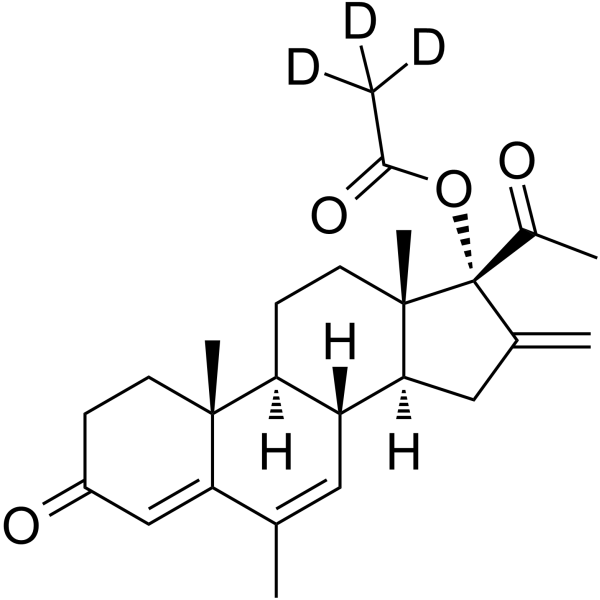
- HY-149495
-
|
|
PROTACs
CDK
|
Cancer
|
|
CP-07 is a potent and selective PROTACCDK9 degrader (DC50: 43 nM). CP-07 inhibits 22RV1 cell proliferation (IC50: 62 nM) and colony formation by down-regulating Mcl-1 and c-Myc. CP-07 inhibits 22RV1 xenograft tumor growth. CP-07 can be used for research of prostate cancer .
|
-
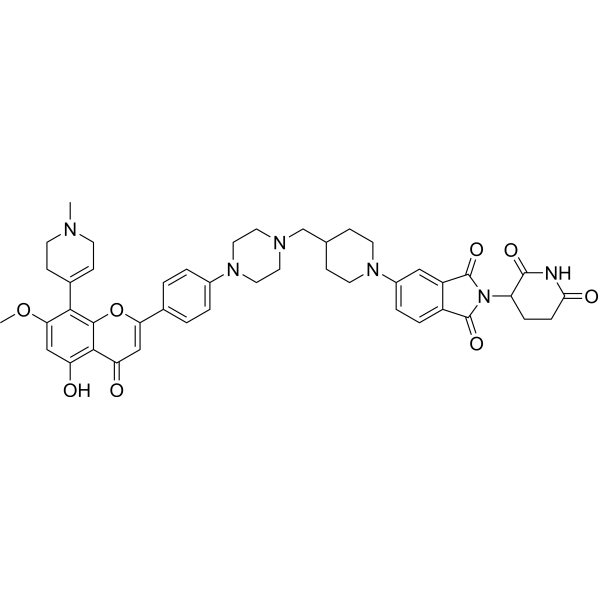
- HY-111614R
-
|
|
Progesterone Receptor
|
Metabolic Disease
Cancer
|
|
Melengestrol acetate (Standard) is the analytical standard of Melengestrol acetate. This product is intended for research and analytical applications. Melengestrol acetate is a progesterone derivative, acts as an orally active corticosteroid hormone to promote endometrial proliferation, pregnancy maintenance, and delay of menstrual activity . Melengestrol Acetate is used as a contraceptive agent for growth promoting effects and suppression of estrus in animals. Melengestrol acetate inhibits both the androgen-dependent and -independent prostatic tumors in vivo and can be used for cancer research .
|
-

- HY-D2132
-
|
|
Fluorescent Dye
|
Cancer
|
|
Sulfo-Cy5.5-ALN is a fluorescent labeled alendronate, which targets bone. Sulfo-Cy5.5-ALN binds to hydroxyapatite and differentiated osteoblasts in vitro. Sulfo-Cy5.5-ALN selectively binds to the mineralized areas of the tumor. Sulfo-Cy5.5-ALN can be used to detect bone overgrowth in prostate bone metastasis .
|
-
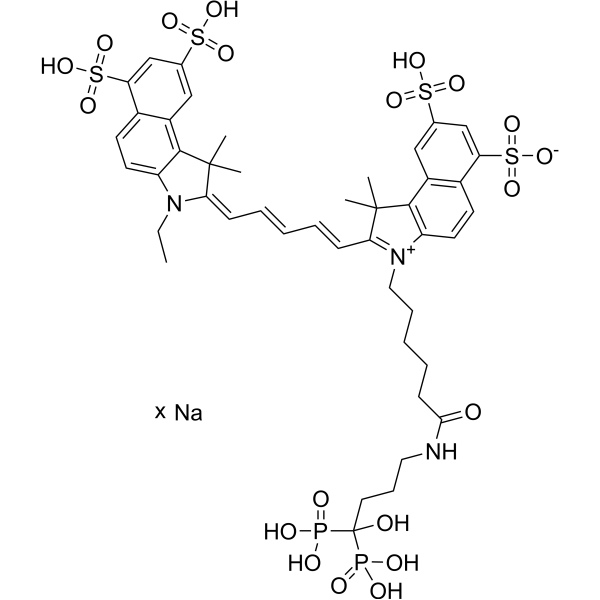
- HY-118487
-
|
|
Others
|
Cancer
|
|
OB-24 is a potent inhibitor of heme oxygenase-1 (HO-1). Heme oxygenase-1, a member of the heat shock protein family, plays a key role as a sensor and regulator of oxidative stress. OB-24 significantly inhibited cell proliferation in vitro and tumor growth and lymph node/lung metastases in vivo. OB-24 has potential for the research of advanced prostate cancer (PCA) .
|
-
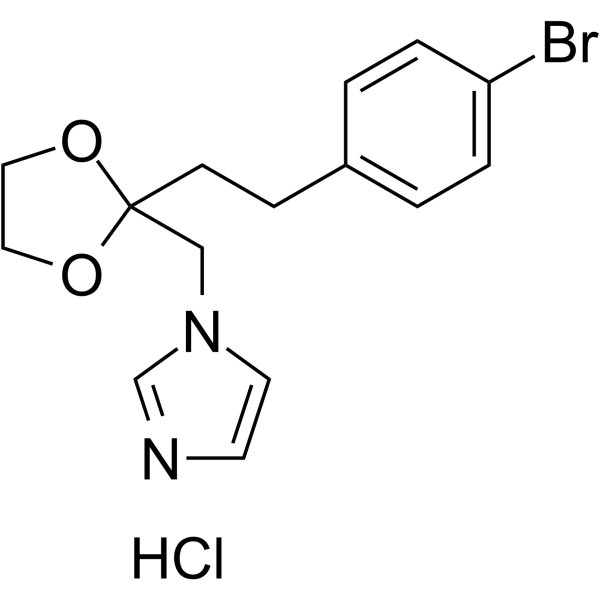
- HY-143660
-
|
|
Microtubule/Tubulin
Apoptosis
|
Cancer
|
|
LG308 is a novel synthetic compound with antimicrotubule activity. LG308 induces mitotic phase arrest and inhibits G2/M progression significantly which is associated with the upregulation of cyclin B1 and mitotic marker MPM-2 and the dephosphorylation of cdc2. LG308 also induces apoptosis and cell death. LG308 significantly suppresses tumor growth. LG308 with antimitotic activity has the potential for the research of prostate cancer .
|
-

- HY-144749
-
|
|
Others
|
Cancer
|
|
AKR1C3-IN-5 (Compound 6e) is a potent inhibitor of AKR1C3. AKR1C3 enzyme is overexpressed in hormone-dependent prostate and breast tumors. AKR1C3-IN-5 derived from drupanin, which exhibits half-maximal inhibitory concentration (IC50) of 9.6 ± 3 μM and selectivity index (SI) of 5.5 against MCF-7 cells .
|
-
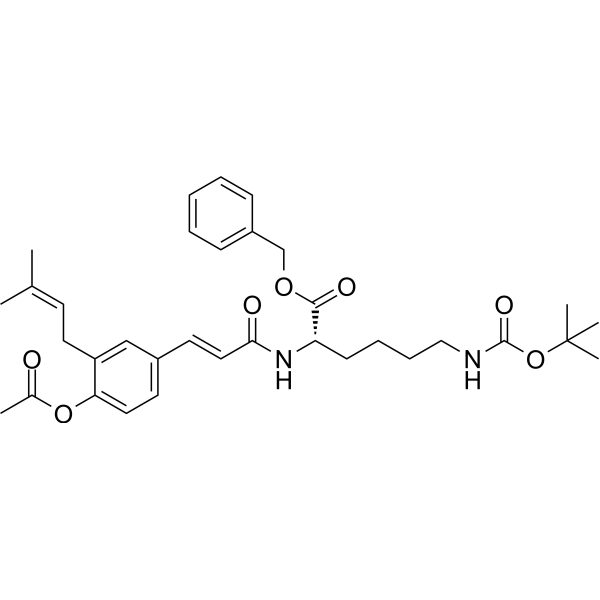
- HY-146494
-
|
|
Androgen Receptor
|
Cancer
|
|
Androgen receptor antagonist 5 (compound 42f) is a potent androgen receptor (AR) antagonist with an IC50 value of 6.17 μM. Androgen receptor antagonist 5 can effectively impair AR nuclear translocation, reducing the levels of nuclear AR, and disrupts AR-mediated gene regulation. Androgen receptor antagonist 5 has antiproliferative activity against LNCaP and exhibits antitumor activity in LNCaP xenograft tumor mice model. Androgen receptor antagonist 5 can be used for researching prostate cancer .
|
-
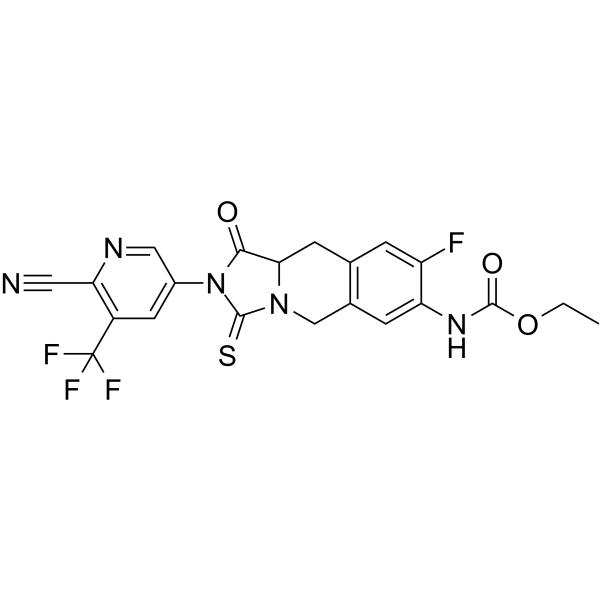
- HY-104040
-
MKC8866
Maximum Cited Publications
8 Publications Verification
Orin1001
|
IRE1
|
Cancer
|
|
MKC8866, a salicylaldehyde analog, is a potent, selective IRE1 RNase inhibitor with an IC50 of 0.29 μM in human vitro. MKC8866 strongly inhibits Dithiothreitol-induced X-box-binding protein 1-spliced (XBP1s) expression with an EC50 of 0.52 μM and unstresses RPMI 8226 cells with an IC50 of 0.14 μM . MKC8866 inhibits IRE1 RNase in breast cancer cells leading to the decreased production of pro-tumorigenic factors and it can inhibits prostate cancer (PCa) tumor growth .
|
-

- HY-144094
-
|
|
Histone Methyltransferase
|
Cancer
|
|
EZH2-IN-9 is a potent inhibitor of EZH2. EZH2 overexpression or mutations in the SET region (Y641F, Y641N, A687V, A677G point mutations) all lead to abnormal elevation of H3K27me3 and promote the growth and development of many types of tumors, such as breast cancer, prostate cancer, leukemia, etc. EZH2-IN-9 has the potential for the research of cancer diseases (extracted from patent WO2021180235A1, compound 17) .
|
-
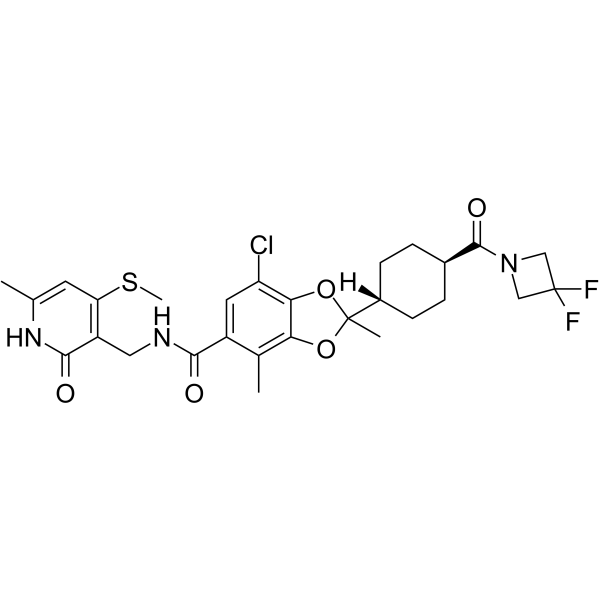
- HY-143616
-
|
|
Histone Methyltransferase
|
Cancer
|
|
EZH2-IN-7 is a potent inhibitor of EZH2. EZH2 overexpression or mutations in the SET region (Y641F, Y641N, A687V, A677G point mutations) all lead to abnormal elevation of H3K27me3 and promote the growth and development of many types of tumors, such as breast cancer, prostate cancer, leukemia, etc. EZH2-IN-7 has the potential for the research of cancer diseases (extracted from patent WO2021129629A1, compound 259) .
|
-
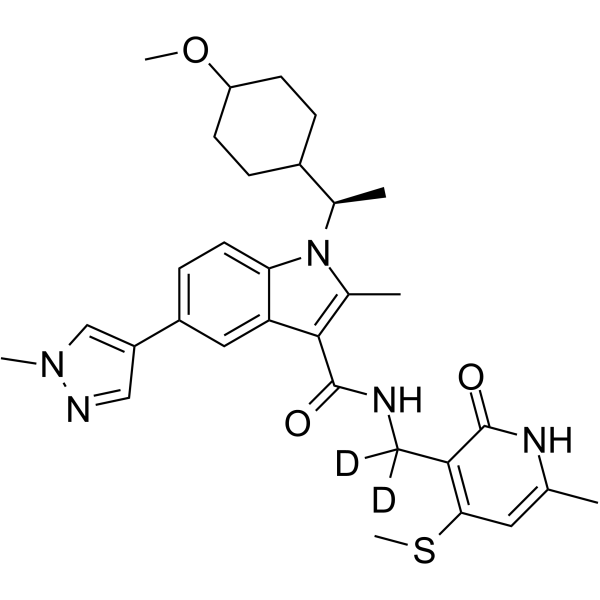
- HY-161023
-
|
|
Others
|
Cancer
|
|
Importin β1-IN-1 (compound DD1-Br) is an orally active Importin β1 inhibitor (KD = 0.219 μM). Importin β1-IN-1 exhibits antiproliferative activity on castration-resistant prostate cancer (CRPC) cells. Importin β1-IN-1 alone or in combination with enzalutamide completely prevented tumor growth in a mouse model of drug-resistant CRPC. Importin β1-IN-1 can be used in cancer research .
|
-
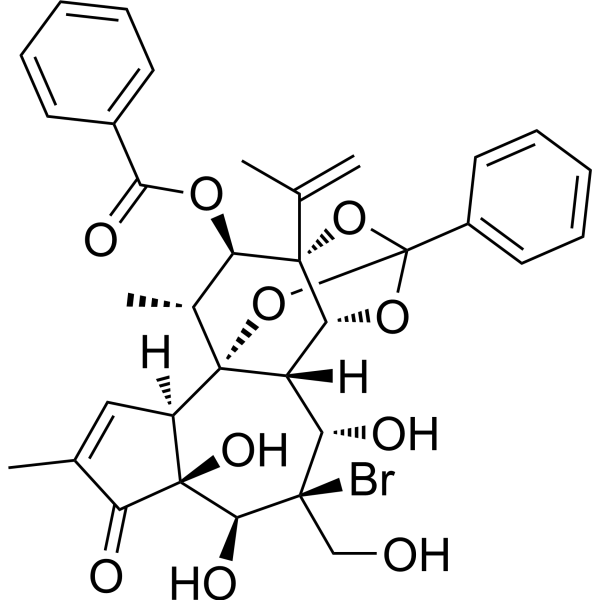
- HY-163510
-
|
|
Androgen Receptor
|
Cancer
|
|
AR/AR-V7-IN-1 (Compound 20i) is an AR/ARV7 inhibitor (IC50 = 172.85 nM). AR/AR-V7-IN-1 potently inhibits cell growth with IC50 values of 4.87 and 2.07 μM in the LNCaP and 22RV1 cell lines, respectively. AR/AR-V7-IN-1 exhibits effective tumor growth inhibition in the 22RV1 xenograft study. AR/AR-V7-IN-1 can be used for the research of prostate cancer .
|
-
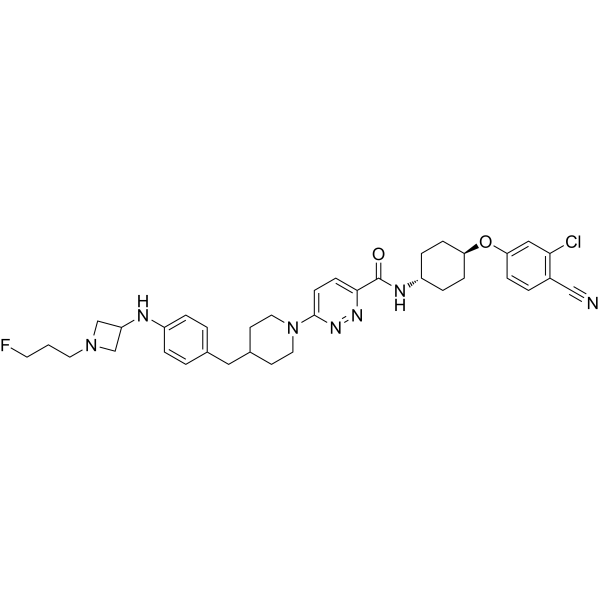
-
-
HY-L107
-
|
|
1,603 compounds
|
|
With features of enormous scaffold diversity and structural complexity, natural products (NPs) are the main sources of lead compounds and new drugs and play a highly significant role in the drug discovery and development process, especially for cancer and infectious diseases. A large number of natural products have been proven to have potential anti-tumor effects, mainly from plants, animals, Marine organisms and microorganisms. At present, derived than 60% of anti-tumor drugs come from natural sources, and they are widely used in breast, prostate and colon cancers.
MCE offers a unique collection of 1,603 natural products with validated anti-cancer activity. MCE anti-cancer natural product library is a useful tool for anti-tumor drugs screening and other related research.
|
| Cat. No. |
Product Name |
Type |
-
- HY-D2132
-
|
|
Fluorescent Dyes/Probes
|
|
Sulfo-Cy5.5-ALN is a fluorescent labeled alendronate, which targets bone. Sulfo-Cy5.5-ALN binds to hydroxyapatite and differentiated osteoblasts in vitro. Sulfo-Cy5.5-ALN selectively binds to the mineralized areas of the tumor. Sulfo-Cy5.5-ALN can be used to detect bone overgrowth in prostate bone metastasis .
|
| Cat. No. |
Product Name |
Target |
Research Area |
-
- HY-P5292A
-
|
|
PSMA
|
Cancer
|
|
HYNIC-iPSMA TFA is a ligand for molecular imaging of tumors. Hynic-ipsma consists of two components: HYNIC (6-hydrazinonicotinamide) and iPSMA (Inhibitor of Prostate-Specific Membrane Antigen). HYNIC is a compound used to attach radioactive isotopes to targeted molecules. iPSMA is a specific inhibitor used to inhibit prostate-specific membrane antigen (PSMA). 68GA-labeled iPSMA has been used to detect prostate cancer by PET imaging. The further 99mTc-EDDA/HYNIC-iPSMA TFA has excellent specificity and sensitivity .
|
-
- HY-P4085
-
|
|
Peptides
|
Cancer
|
|
AGR is a peptide. AGR recognizes lymphatic vessels in fully developed prostate tumors but not in the pre-malignant lesions .
|
-
- HY-P5290
-
|
|
PSMA
|
Cancer
|
|
HYNIC-PSMA is a ligand for molecular imaging of tumors. Hynic-psma consists of two components: HYNIC (6-hydrazinonicotinamide) and PSMA (Prostate-Specific Membrane Antigen). HYNIC is a compound used to attach radioactive isotopes to targeted molecules, such as 188Re-HYNIC-PSMA. PSMA is a membrane antigen that is specifically expressed on the surface of prostate cancer cells. HYNIC-PSMA can be used in prostate cancer research .
|
-
- HY-P5292
-
|
|
PSMA
|
Cancer
|
|
HYNIC-iPSMA is a ligand for molecular imaging of tumors. Hynic-ipsma consists of two components: HYNIC (6-hydrazinonicotinamide) and iPSMA (Inhibitor of Prostate-Specific Membrane Antigen). HYNIC is a compound used to attach radioactive isotopes to targeted molecules. iPSMA is a specific inhibitor used to inhibit prostate-specific membrane antigen (PSMA). 68GA-labeled iPSMA has been used to detect prostate cancer by PET imaging. The further 99mTc-EDDA/HYNIC-iPSMA has excellent specificity and sensitivity .
|
| Cat. No. |
Product Name |
Target |
Research Area |
-
- HY-P99217
-
|
AMG 102
|
c-Met/HGFR
|
Cancer
|
|
Rilotumumab (AMG 102) is an anti-HGF (anti-hepatocyte growth factor) monoclonal antibody, inhibits HGF/MET-driven signaling. Rilotumumab shows anti-tumor activity, and can be used in castration-resistant prostate cancer (CRPC) and solid tumor research .
|
-
- HY-P99554
-
|
PRX-302
|
Inhibitory Antibodies
|
Cancer
|
|
Topsalysin is a PSA-activated protoxin, a pore-forming protein (synthetic proaerolysin) fusion protein with human prostate-specific antigen. Topsalysin has tumor suppression effect in mice modle .
|
| Cat. No. |
Product Name |
Category |
Target |
Chemical Structure |
| Cat. No. |
Product Name |
Chemical Structure |
-
- HY-111614S2
-
|
|
|
Melengestrol acetate-d3 is the deuterium labeled Melengestrol acetate. Melengestrol acetate is a progesterone derivative, acts as an orally active corticosteroid hormone to promote endometrial proliferation, pregnancy maintenance, and delay of menstrual activity[1]. Melengestrol Acetate is used as a contraceptive agent for growth promoting effects and suppression of estrus in animals. Melengestrol acetate inhibits both the androgen-dependent and -independent prostatic tumors in vivo and can be used for cancer research[2].
|
-

-
- HY-111614S
-
|
|
|
Melengestrol acetate-d6 is the deuterium labeled Melengestrol acetate. Melengestrol acetate is a progesterone derivative, acts as an orally active corticosteroid hormone to promote endometrial proliferation, pregnancy maintenance, and delay of menstrual activity[1]. Melengestrol Acetate is used as a contraceptive agent for growth promoting effects and suppression of estrus in animals. Melengestrol acetate inhibits both the androgen-dependent and -independent prostatic tumors in vivo and can be used for cancer research[2].
|
-

-
- HY-111614S1
-
|
|
|
Melengestrol acetate-d2 is the deuterium labeled Melengestrol acetate. Melengestrol acetate is a progesterone derivative, acts as an orally active corticosteroid hormone to promote endometrial proliferation, pregnancy maintenance, and delay of menstrual activity[1]. Melengestrol Acetate is used as a contraceptive agent for growth promoting effects and suppression of estrus in animals. Melengestrol acetate inhibits both the androgen-dependent and -independent prostatic tumors in vivo and can be used for cancer research[2].
|
-

Your information is safe with us. * Required Fields.
Inquiry Information
- Product Name:
- Cat. No.:
- Quantity:
- MCE Japan Authorized Agent:








































































